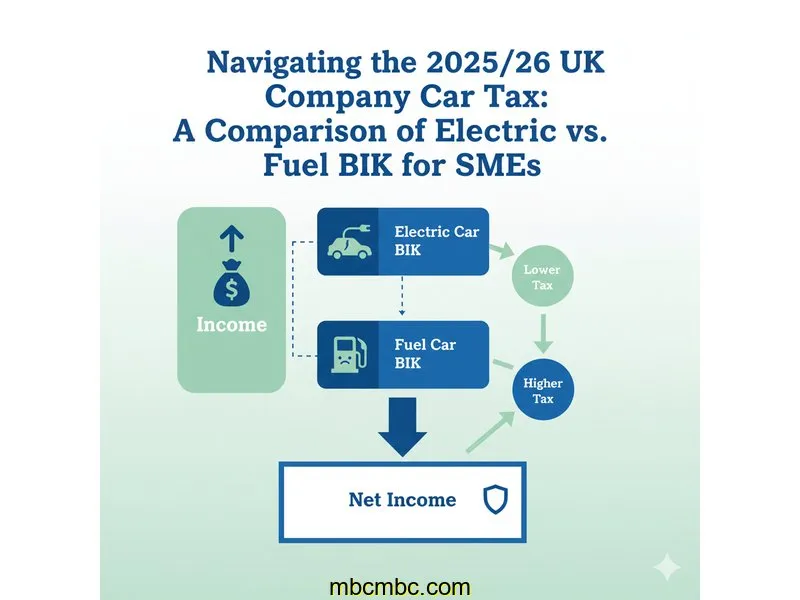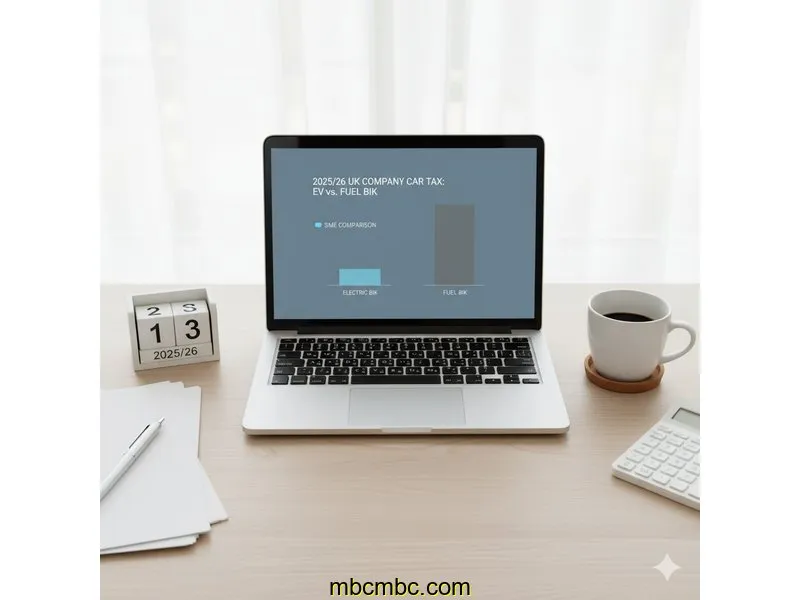
If you're a small business owner or an employee considering a company car in the UK, the choice is more complex than just picking your favourite make and model. The hidden factor that transforms a perk into a major cost is **Benefit-in-Kind (BIK) tax**. For too long, company cars were synonymous with chunky tax bills, but the landscape has changed dramatically with the drive towards electrification.
In this guide, I, Alex Williams from FinTools UK, want to break down exactly how the UK’s Company Car Tax rules will impact you in the 2025/26 tax year, especially for those standing at the crossroads of choosing a petrol, hybrid, or pure electric vehicle. Understanding these rates is the key to making a financial decision that benefits both the company and the employee, and is particularly vital for SMEs managing budgets and seeking greener credentials.
Quick Summary: Company Car BIK in 2025/26
- The Core Factor: BIK is calculated based on the car's **P11D value** (list price + accessories + VAT - first year registration fee) and its **official CO2 emissions** (which determines the BIK percentage rate).
- The Electric Advantage: The BIK rate for zero-emission electric vehicles (EVs) remains exceptionally low but is scheduled for a modest, planned annual increase. For 2025/26, this rate is a mere 3%.
- Fuel Type Matters: High-polluting petrol and diesel cars will continue to attract the highest BIK rates, maxing out at 37% of the P11D value. The gap between an EV and a traditional combustion engine car is now wider than ever.
- The Tax Impact: The resulting BIK value is added to the employee's taxable income, and they pay income tax at their marginal rate (20%, 40%, or 45%) on that amount.
What Exactly is a "Benefit-in-Kind" and P11D?
In simple terms, a Benefit-in-Kind is a perk you receive from your employer that isn't included in your wages, but still holds monetary value. HMRC sees a company car as a taxable benefit because you get personal use out of it. It’s essentially a part of your total compensation package, which is why it gets taxed.
The calculation starts with the car's **P11D value**. Think of the P11D as the total sticker price for tax purposes. It includes the list price, any optional extras (like upgraded trim or paint), and VAT, but crucially, it excludes the car’s first registration fee and road tax (Vehicle Excise Duty). It's the most important figure for the BIK calculation.
Next, the BIK percentage rate is applied to the P11D value. This rate is set by HMRC and depends entirely on the car's **CO2 emissions**. The higher the emissions, the higher the percentage rate, which in turn leads to a higher annual tax charge for the employee.
The 2025/26 BIK Rate Divergence: Why Emissions are Key
The UK government has strategically frozen or increased BIK rates to incentivise the shift to low-emission vehicles. This has created a massive chasm in the tax payable depending on your car's fuel type and CO2 output, a critical point for SMEs making fleet decisions. As an analogy, think of the BIK rate as a sliding scale on a seesaw—the heavier the environmental impact (higher CO2), the higher the tax end of the seesaw rises.
For the 2025/26 tax year, the core focus remains on the low-emission categories. For a pure **Electric Vehicle (EV)** with zero emissions, the BIK rate is scheduled to rise from 2% to **3%**. While this is an increase, it remains an extremely low figure, especially when compared to traditional petrol or diesel cars which typically sit in the 20% to 37% range.
Key Rule Update: According to the HM Treasury's forward plan from the 2023 Budget, the BIK rates for the lowest emission cars (0-50g/km) are set to increase by just one percentage point per year for three years, starting in 2025/26. This long-term certainty allows businesses to plan their fleet strategy with confidence, knowing the tax benefit for EVs will be protected for years to come.
The Cost: Taxpayer Impact Comparison for an SME
To illustrate the sheer financial difference, let’s look at how the BIK percentage translates into an actual tax bill for an employee who is a **Basic Rate (20%) taxpayer**. We’ll use a P11D value of £35,000 across three common vehicle types. This comparison highlights why the shift to electric vehicles is becoming an overwhelming choice from a tax perspective.
| Car Type Example | CO2 (g/km) Range | 2025/26 BIK Rate | Annual BIK Charge (£) | Annual Tax Bill (20% Taxpayer) (£) |
|---|---|---|---|---|
| Pure Electric Vehicle (EV) | 0 | 3% | 1,050 | 210 |
| Plug-in Hybrid (PHEV) | 51-75 | 15% | 5,250 | 1,050 |
| Standard Petrol/Diesel | 140+ | 25% | 8,750 | 1,750 |
As you can see, the basic rate taxpayer in the high-emission car pays over eight times the tax of the EV driver. The BIK charge is a significant chunk of money. This difference in tax liability is why the company car calculator is one of the most popular tools on FinTools UK—it puts the cost in black and white.
Beyond the Tax Bill: Other Factors for SMEs
While BIK is the employee's main concern, SMEs must consider other tax reliefs that make EVs even more attractive:
- Capital Allowances: For companies, cars with zero CO2 emissions generally qualify for **100% First-Year Capital Allowances (FYAs)**. This means the business can deduct the full cost of the vehicle from its profits before tax in the year of purchase. Traditional fuel cars only qualify for a much lower rate (or 18% main rate for low-emission non-EVs), making the EV a much faster way to reduce corporation tax.
- National Insurance Contributions (NICs): The company has to pay Class 1A NICs on the BIK value at a rate of 13.8%. A lower BIK value for the EV means a lower NICs bill for the employer, saving the business significant money year after year.
- Advisory Fuel Rates (AFRs): For reimbursing employees for business mileage, HMRC's AFRs for electric cars are generally lower than those for petrol or diesel, leading to lower business overheads for mileage claims.
How Calculators Help Understand BIK

The calculations above are simplified scenarios. In the real world, BIK can be affected by factors like the car's registration date, accessories added after purchase, and any capital contributions made by the employee. A specialised online BIK calculator simplifies this process. It takes the P11D value, the CO2 emissions, and your personal tax bracket, and instantly shows the annual BIK charge and the corresponding income tax payable. This eliminates the risk of human error and allows employees and employers to run side-by-side comparisons of different vehicle choices, which is essential before signing any agreements.
Common Questions About Electric Company Car BIK
If I pay an employee contribution towards the car's cost, does that reduce the BIK amount?
Yes, it does. Any capital contribution made by the employee towards the cost of the car (up to a maximum of £5,000) will reduce the P11D value used in the BIK calculation. This contribution is a one-off payment, not monthly installments, and the resulting reduction in BIK charge is effective for the lifetime of the car under the current employer.
Do company car BIK rules apply if the vehicle is a van used solely for business?
No, the rules are different for company vans. If the van is used exclusively for business and any private use is only 'insignificant' (like a quick detour on the way home), then there is no BIK charge. If private use is significant, a fixed annual BIK charge applies, which is much simpler than the car calculation, regardless of the van's value or emissions.
What happens to the BIK calculation if I choose a car that has been discontinued or is 'older'?
The BIK calculation always uses the car's original P11D value when it was new, regardless of how old the vehicle is when you receive it. Its current market value or a reduction for depreciation is not a factor. This is why choosing a high-spec, high-emission car that is a few years old can still result in a disproportionately high BIK charge.
The transition to electric vehicles is being heavily supported by the UK tax system, and the scheduled BIK rate increases for the 2025/26 tax year and beyond are still negligible compared to traditional fuel cars. This makes the EV an increasingly compelling financial choice for both the SME and the employee.
Remember, this information is for educational purposes only. Tax rules are complex and constantly changing. Before making a major financial commitment like a company car or fleet purchase, you should always consult a qualified accountant to assess your specific business and personal tax situation.

